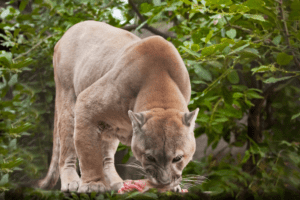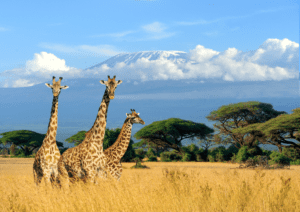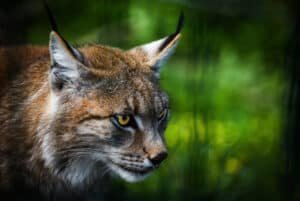The Panther is dark brown to the black color big cat that looks like any other feline species. However, the black coloration is associated with the melanism characteristic for which it is named Black Panther. The Florida Panther, which is considered a sub-species of Cougar and is infrequently found in dark brown color and has dark spots upon the skin, is the only genuine exception.
It is found in the southeast part of the United States. On its long body and tail, the Panther has a lustrous dark fur coat rather than markings, unlike Jaguars and Leopards. By physical appearance, Black Panther has a small-sized head, powerful jaws, and bright green eyes, and their hind legs are larger and slightly longer than their front legs.
In the Big Cat family, the Panthers are not only one of the world’s largest felines, but the characteristic of roaring is also present in them, whereas, this distinct characteristic has not been observed in any other group within the felines family. However, the black coloration is associated with the melanism characteristic.
Table of Contents
Taxonomic Classification
Black Panther Panthera pardus is indeed a carnivorous mammal that belongs to the Felidae family. The Panther is not a unique species, but rather a generic term for any black-colored feline in the family of Big Cats, including Jaguars and Leopards.
The Panther is a secretive and powerful species, adapted to a wide range of settings over the globe and is renowned as one of the greatest climbers of entire family felines.
Habitat and Distribution
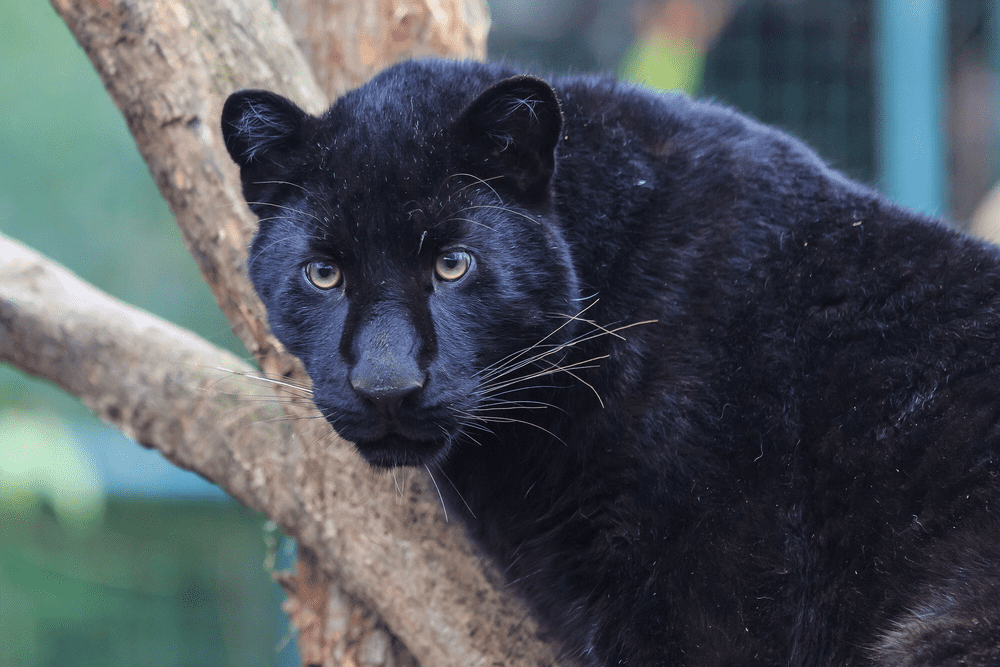
Panthers are indigenous to three continents i.e. Central, South America and United States. Black Jaguar and Black Leopard belong to different locations on the globe. Almost thirty subspecies of Leopards can be found in Asia and transitions of the Sahara desert in Africa.
The Panther can be found in a diversity of habitats, including tropical and deciduous woods, swampland, marshes, grasslands, and even more inhospitable environments like deserts and mountains. The Panther, like many the big cats’ felines, is now becoming increasingly scarce in wild ecosystems, owing to the loss of habitat from deforestation.
Da Silva et al., (2017) depicted in their research that Natural selection has a major influence on leopard melanism, which is to be expected driven by the efficacy of camouflage and thermoregulation in diverse environments, as well as a moisture effect that goes beyond its influence on vegetation type. His findings back up traditional notions of adaptive coloring in animals and open up new paths for in-depth evolutionary studies of melanism in mammals.
Hence the association of ecosystem type and Melanism in Panthera pardus has been exclusively studied. Melanism was most common in tropical and subtropical wet forests, particularly in the Indian forests, forests of Javan, and Peninsular rain forest ecosystems of Malaysia, despite leopards being found in eleven different ecosystems.
The frequencies of the two morphologies were considerably different from the zero assumption based on the total frequency across the range in four different biomes. This was especially true in tropical and subtropical wet broadleaf forests, where black animals made up 30% of the population or roughly three times the expected frequency.
Melanism was much less common than expected in the xeric environment, temperate and mixed forest ecosystems, tropical and subtropical grassland ecosystem, scrublands, and tropical savannahs and scrublands.
Chronobiology

Panthers are exceptionally bright and nimble animals that are rarely observed by humans in the wild due to their quiet and cautious nature. The Panther’s dark brown fur blends perfectly with the adjacent woodland and makes them nearly unnoticeable in the darkness of night. The Panthers are nocturnal mammals that spend much of the daytime resting safely at heightened trees and usually pray during the night.
Panthers are great climbers who can not only rest in the trees but also keep hidden and a lookout for prey. The Panther is an extraordinarily powerful and fearless animal with having very aggressive nature. Panther males, especially those whose niche overlap those of several females and are threatened by another male, are extremely territorial.
Mode of Reproduction
Although there are only two species of Panthers, Jaguars and Leopards are quite similar regardless of diverse distribution over the planet. Black Jaguars and Leopards frequently have litters with spotted babies, with females normally giving birth to two to four pups after a three-month gestation period.
The newborn cubs of Panthers are blind and cannot open their eyes until they reach the age of at least two weeks. When they are left alone by their mother, they are especially vulnerable to predators. The cubs of Panther begin to join their mother in the hunt for prey when they are a few months old, and they remain with her mother until they reach approximately two years of their age and after then create their territory.
Feeding behavior

In their natural habitat, the Panthers are the most feared and powerful predators among carnivorous mammals. Owing to the dark skin of the Panther it is difficult to notice while hunting at night, allowing it to travel through the jungle fully unseen. Although they perform hunting mostly on the ground, there is evidence of their hunting habits from trees, allowing them to trap their prey from a distance.
The Panther’s diet varies depending on where it lives, however, medium size herbivore animals make up the majority of their diet. Panthers hunt a variety of animals, including antelope, deer, wild boar, warthogs, and tapir, as well as lesser species like rabbits and birds if the prey is scarce and they find an easy opportunity for prey.
Role in Ecology
Panthers are carnivore animals, in the food chain or trophic levels panthers are secondary consumers and have a key role in maintaining ecological balance by keeping the population of primary consumers under the carrying capacity. In the densest tropical ecosystems of the world, Panthers have the most dominant position among all predators.
Read Also: How Many Black Panthers Are Left in the World?
Predators and Threats
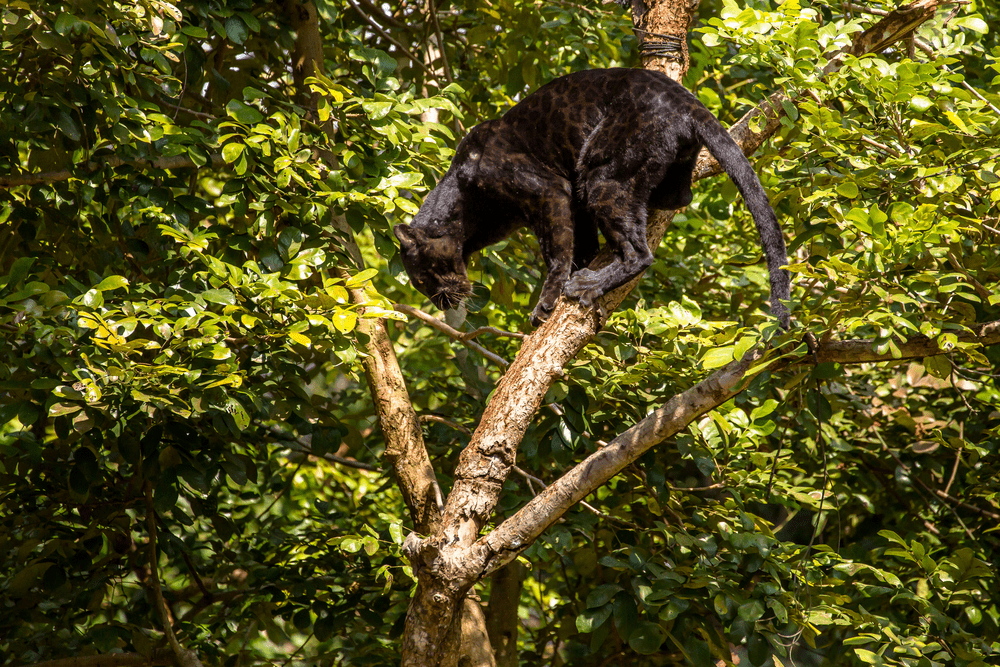
Panthers are considered the most dominant predator in this modern world. Competition among predator are commonly observed but large Hynes, Lions, and Tigers rarely attack, but humans are the greatest threat to all species of Panthers. These uncommon species have not only been observed hunting by humans but also been observed destroying their natural habitat and niche subjected to a dramatic loss of habitat, particularly as a result of deforestation.
Panthers are becoming even rarer than they were before, as their numbers are dropping all across the globe and they are being driven into shrinkage of their original habitats.
Relationship with Humans

People have hunted the Big Cats as trophies and skin, notably in the last couple of centuries. Leopard and Jaguar populations have suffered massive decreases as a result of this, with certain portions of their original range being completely lost. Panthers have also suffered from severe habitat loss across much of America, Africa, and Asia, making these stealthy predators even uncommon.
It is not difficult to reorganize the presence of Panthers by native people because of their local skill and panthers’ characteristics of leaving tracks and scratching marks on trees, therefore they are rarely seen. Panthers are commonly known as “the ghost of the jungle” because of their cunning.
IUCN Conservation Status
Even though the Black Panther is not regarded as a separate species by the biodiversity experts, Jaguars and Leopards are becoming increasingly threatened across the globe, and are designated as Threatened by the International Union for the conservation of nature (IUCN).
Many biodiversity specialists consider these feline species to be endangered because Black Panther produces when two gene-carrying individuals breed, and the chances of the deed are decreasing owing to habitat degradation.
Suggestions for Conservation
Urbanization is spreading at unprecedented speed over time on Earth which is unstoppable. Along with urbanization, many problems arise. Four of the major problems are climate change, shrinking and depletion of natural resources such as forests and habitat destruction, Pollution and human interference, and encroachment into forests.
All these problems are directly associated with the terrible decline in the population of Panthers.
Some of the wild species have high adaptability, with it they evolve and adapt over time with changing environment but especially the Black panther has very distinct behavior and most of the time they live alone or in pair in their territory or niche and very difficult to find because of their shy behavior to exotics i.e. Humans. So the 1st suggestion is the protection of their habitat by making protected areas by respective Government bodies.
There must be a Global convention or protocol for the conservation of particularly Panther species.
On the planet earth, the most dominant species which has an impact and influence on all types of environment is humans and it is the biggest known pest for all ecosystems. Also human is the most intelligent creature. It is within the access and duty of humans to protect and conserve the species for the sake of a healthy environment and humanity itself.
There are very less studies and Researches Black Panthers. There is much need for study and research on habitat preferences, ecology, behavior, and circadian rhythm of panther species for their conservation.
Read Also: Where do Wildcats Live


